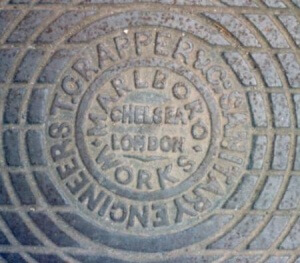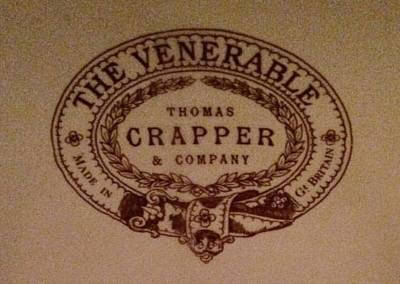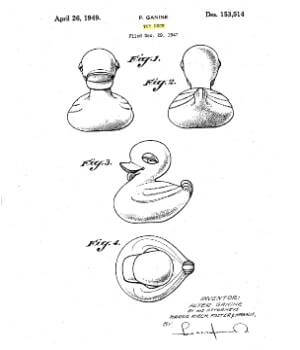January 27 is Thomas Crapper Day
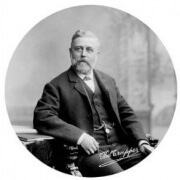 Today is Thomas Crapper Day and commemorates the death, in 1910, of the man widely believed to have invented the flush toilet. Although that is, as they say, crap, Crapper was a shrewd marketer, leveraging his status as plumber to the British royal family to popularize indoor plumbing. He owned the first showroom of bathroom facilities and publicized the toilet at a time when no one spoke of such “necessities.”
Today is Thomas Crapper Day and commemorates the death, in 1910, of the man widely believed to have invented the flush toilet. Although that is, as they say, crap, Crapper was a shrewd marketer, leveraging his status as plumber to the British royal family to popularize indoor plumbing. He owned the first showroom of bathroom facilities and publicized the toilet at a time when no one spoke of such “necessities.”
Crapper is one small part of the largely untold history of the device that transformed the world. Humans have been building indoor plumbing for millennia. Excavations have shown evidence of flushing toilets dating back as far as 2600 B.C., during the mature Harappan phase of the Indus Valley Civilization.
John Harrington (also spelled Harington) invented a version in 1596 with a cord that, when pulled, would allow a rush of water from the “water closet,” flushing away waste. He installed one at his home and also built one for his godmother, Queen Elizabeth I. He called it the Ajax as a play on”jakes,” a slang term for toilet in use at the time. He may be the reason we sometimes call it a “john.”
An author, Harrington wrote “A New Discourse upon a Stale Subject: The Metamorphosis of Ajax.” Superficially, its subject was his invention; in truth, it was a thinly-veiled allegory about political stercus (manure) poisoning the state. The book got him banished from court for a time, and the queen referred to him as her saucy godson.
(Side note: A scent called Stercus was introduced at Smell Festival 2014 in Bologna, Italy. The perfumer named his brand Orto Parisi to honor his grandfather, who fertilized his garden with his own excrement. The bottle was displayed on a slab of dried, pressed manure inside a golden frame. Order here if you dare.)
Fellow Brits refined Harrington’s design. Alexander Cumming invented the S-trap in 1775, which used a sliding valve called a “stink trap” to seal the bowl’s outlet and prevent sewer stench from entering the home. It is still in use today. Two years later, Samuel Prosser patented the “plunger closet,” which featured a separate flush tank.
After noticing that toilets he installed in London tended to freeze in winter, Joseph Bramah replaced the sliding valve with a hinged flap and also developed a float valve system for the flush tank. Many sources state that a coworker named Mr. Allen devised the apparatus. But Bramah received the patent in 1778 and, as a result, we can’t even find Allen’s first name in historical records. In 1852, George Jennings patented his own improvements and later constructed London’s first public toilets.
At last, we’re back to where we started. When did Thomas Crapper receive patent #4990, prominently featured in his advertisements? He didn’t. Albert Giblin was awarded patent #4990 for his “Improvements to Flushing Cisterns” in 1898. (Many sites mistakenly report the year as 1819. We have located the original patent and drawings.)
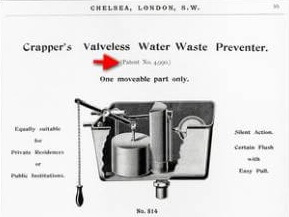
Adam Hart-Davis of Exnet used the British Library to painstakingly track down all patents awarded to Thomas Crapper. According to him, “Mr. Crapper took out exactly six, starting in 1881 (#1628) to do with ventilating house drains, and ending in 1893 (#11604) for a mechanism to flush a lavatory by means of a foot lever. None of his patents was #4990. None of his patents was for a valveless water-waste preventer (WWP).”
It’s possible that Giblin, of whom little else can be learned, sold his patent to Mr. Crapper. What we can state with certainty is that Thomas Crapper and Company, claiming to be “The Original Patentees and Manufacturers of Bathroom Appliances,” is still in business today.
The company website tells the story of Crapper’s design of the first automatic flush toilet with a springloaded seat that would fly up, pulling rods which would trigger the flushing action. Unfortunately, with time and use, the rubber buffers attached to the seat’s underside began to break down and become sticky.
“This caused the seat to remain down, attached to the loo pan for a few seconds as the user got to his feet. Seconds later the seat, under stress from the powerful springs, would free itself and sweep violently upwards – striking the unfortunate Victorian on the bare bottom!”
It became known as the “Bottom Slapper” and was not a commercial success. (One could say it was a hit and then it wasn’t.) We trust that the royal family, who contracted Crapper to install plumbing fixtures at Buckingham Palace and Windsor Castle, were never subjected to that indignity.
Manhole covers bearing the company name have become minor tourist destinations. One in particular outside Westminster Abbey, another site supplied by Crapper, has become a popular spot to take brass rubbings. Some of the enthusiasm for this activity may be due to the misconception that the term “crap” as slang for human waste originated with Thomas Crapper. In fact, it predated him by hundreds of years.
He may have been indirectly responsible for the American habit of calling a toilet “the crapper.” Every time U.S. soldiers stationed in Britain during World War I used a bathroom, they saw “CRAPPER” in the porcelain of the toilet and sink. The association between “crap,” “Crapper,” and the act of crapping in a Crapper was so irresistibly hilarious that they brought it home with them, and their descendants continue to use it every day—-in word and deed.
If this holiday, focused as it is on a distasteful bodily function, seems undeserving of your attention, ask yourself this question: If you could only choose one, which could you live without? Your toilet or your iPhone?
Take that, Apple.
![]()


